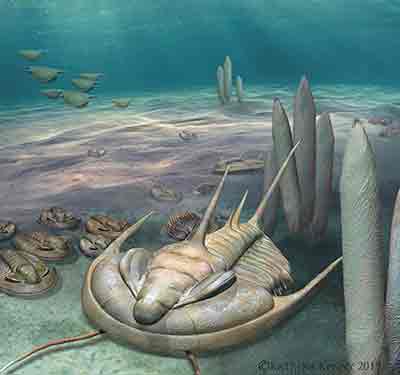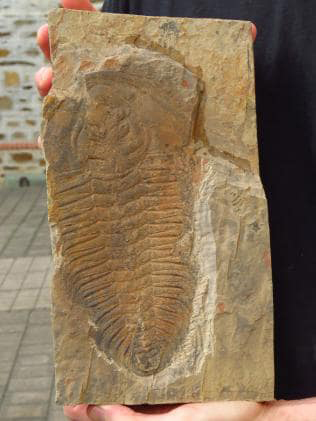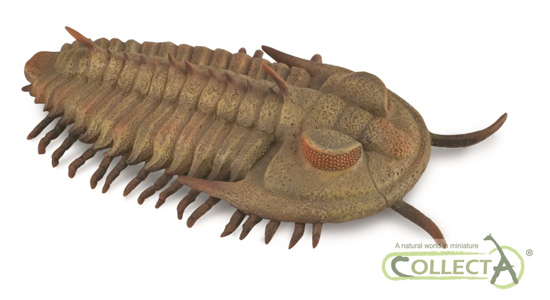Redlichia rex – Fearsome Predator of Trilobites
A team of scientists have described a new species of trilobite and at around thirty centimetres in length, this new species is the largest member of the Trilobita from Australia to have been described to date. Writing in the academic publication, the Journal of Systematic Palaeontology, the team consisting of researchers from the University of Adelaide, South Australian Museum and the University of New England describe Redlichia rex and suggest that it probably specialised in attacking and eating smaller trilobites. It might even have been a cannibal!
Redlichia rex
Lead author of the research, James Holmes, a PhD student at the University of Adelaide commented:
“We decided to name this new species of trilobite Redlichia rex (similar to Tyrannosaurus rex) because of its giant size, as well as its formidable legs with spines used for crushing and shredding food, which may have been other trilobites.”
A Life Reconstruction of the Newly Described Trilobite Species Redlichia rex
Picture credit: Katrina Kenny
An Exceptional State of Preservation
The fossil material comes from an exceptional Lagerstätte known as the Emu Bay Shale on Kangaroo Island, South Australia, these sediments represents shallow sea deposits laid down in the Early Cambrian. Around fifty different species of trilobite have been described from this location. Well-preserved, fully articulated specimens from this deposit are known to reach lengths in excess of 25 centimetres, representing one of the largest known Cambrian trilobites. Until now, all Redlichia specimens from the Emu Bay Shale have been referred to as Redlichia takooensis.
Previous studies recognised considerable differences in exoskeletal shape and morphology among specimens of varying sizes, which were thought to represent different growth stages of the same species (ontogeny). However, close examination of a large collection of recently acquired specimens shows that this variation actually represents two distinct morphs, interpreted by the researchers as representing a distinct and larger species – Redlichia rex.
PhD Student James Holmes with a Fossil of R. rex
Picture credit: University of Adelaide
Redlichia rex – Around 30 cm in Length
Many of the fossils demonstrated an exceptional state of preservation with soft parts such as the antennae and the legs preserved. At around 30 centimetres in length, Redlichia rex is almost twice as big as most other Australian trilobites recorded from Cambrian-aged rocks.
Co-study author, Diego García-Bellido, from the University of Adelaide and the South Australian Museum added:
“Interestingly, trilobite specimens from the Emu Bay Shale, including Redlichia rex, exhibit injuries that were caused by shell-crushing predators. There are also large specimens of fossilised poo (coprolites), containing trilobite fragments in this fossil deposit. The large size of injured Redlichia rex specimens and the associated coprolites suggests that either much bigger predators were targeting Redlichia rex, such as Anomalocaris – an even larger shrimp-like creature – or that the new species had cannibalistic tendencies.”
Evidence of an Evolutionary Arms Race
The naming of this new species demonstrates the diversity of the marine biota within this ancient sea environment and supports the idea that one of the principle drivers of the “Cambrian explosion” was the evolutionary “arms race” between predators and prey species. As predators became larger and more efficient hunters, so primary producers and secondary predators developed more effective defences, this in turn led to the evolution of more deadly predator species.
A Fossil Specimen (Redlichia rex)
Picture credit: University of Adelaide
James Holmes commented:
“The overall size and crushing legs of Redlichia rex are a likely consequence of the arms race that occurred at this time. This giant trilobite was likely the terror of smaller creatures on the Cambrian seafloor.”
Fossils of the amazing Cambrian marine biota including specimens of Redlichia rex are currently on display at the South Australian Museum (Adelaide).
A CollectA Redlichia rex Trilobite Model
To view the model of Redlichia rex (whilst stocks last) and other prehistoric animal models: CollectA Prehistoric Life Figures.
The scientific paper: “The trilobite Redlichia from the lower Cambrian Emu Bay Shale Konservat-Lagerstätte of South Australia: systematics, ontogeny and soft-part anatomy” by James D. Holmes, John R. Paterson and Diego C. García-Bellido published in the Journal of Systematic Palaeontology.










Leave A Comment